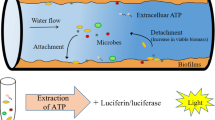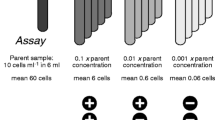Abstract
To reduce the spread of aquatic invasive species, the discharge of ballast water by ships will soon be compulsorily regulated by the International Maritime Organization (IMO) and the United States Coast Guard (USCG). Compliance with their regulations will have to be achieved by onboard ballast water management systems. To monitor the treatment system performance, rapid and easy compliance techniques are required. This paper reports on the suitability of adenosine triphosphate (ATP) to quantify living 10–50-μm organisms at <10 cells mL−1, which is the upper limit of the IMO D-2 and USCG regulations. Initial tests revealed that commercially available ATP assays lacked sufficient sensitivity to monitor ATP in treated ballast water. A rapid and easy concentration method was developed to increase sensitivity and remove interfering salts, non-target organisms (Micromonas pusilla), and dissolved ATP. Laboratory experiments revealed that salinity was reduced 33 times and concentration efficiencies reached 85 %. The ATP assay was tested in a UV-based full-scale ballast water management system, treating seawater and fresh water. ATP levels were compared with two alternative compliance tools: fluorescein diacetate (FDA) and Photosystem II efficiency. Results showed a 10-fold decrease in ATP levels after treatment compared to a 5-fold decrease in alternative compliance techniques. Following refinements, the ATP assay’s detection limit reached 2.5 ± 0.5 cells mL−1 using a Thalassiosira rotula monoculture. Initial estimates of the pass and fail level were 50 and 6000 relative luminescence units, respectively. Further validation is recommended. The ATP assay is a promising tool for ballast water compliance testing.






Similar content being viewed by others

References
Anonymous (2004) International convention for the control and management of ships’ ballast water and sediments, vol BWM/CONF/36. IMO, London
Anonymous (2005) Guidelines for approval of ballast water management systems (G8). Annex 3, vol MEPC.125 (53). IMO, London
Anonymous (2008a) Guidelines for approval of ballast water management systems (G8). Annex 4, vol MEPC.174 (58). IMO, London
Anonymous (2008b) Guidelines for ballast water sampling (G2). Annex 3, vol MEPC.173 (58). IMO, London
Anonymous (2009) Method 8167; Chlorine, Total (0 to 2.00 mg/L) for water, wastewater and seawater. In: Hach DR/890 colorimeter procedures manual, vol 22. Hach Company, Loveland, Colorado, USA, pp 141-146
Anonymous (2012) Standards for living organisms in ships’ ballast water discharged in U.S. waters; Final Rule. vol 77. United States Coast Guard, Federal Register
Anonymous (2013) Guide to ballast water treatment systems, vol 1. IHS Fairplay, Coulsdon
Anonymous (2014) Speedy Breedy. Ballast water treatment system (BWTS) installation is one thing – meeting the IMO gross non-compliance (GNC) standard is another. Goltens, Groningen
Carter HT, Tipping E, Koprivnjak JF, Miller MP, Cookson B, Hamilton-Taylor J (2012) Freshwater DOM quantity and quality from a two-component model of UV absorbance. Water Res 46:4532–4542
Cullen JJ, Renger EH (1979) Continuous measurement of the DCMU-induced fluorescence response of natural phytoplankton populations. Mar Biol 53:13–20
de Lafontaine Y, Despatie SP, Veilleux E, Wiley C (2008) Onboard ship evaluation of the effectiveness and the potential environmental effects of PERACLEAN (R) ocean for ballast water treatment in very cold conditions. Environ Toxicol 24:49–65
Delacroix S, Liltved H (2013) Preliminary validation of a sampling procedure developed by SGS Germany. NIVA, Drøbak
Drake JM, Lodge DM (2007) Rate of species introductions in the Great Lakes via ships’ ballast water and sediments. Can J Fish Aquat Sci 64:530–538
First MR, Drake LA (2014) Life after treatment: detecting living organisms following exposure to UV light and chlorine dioxide. J Appl Phycol 26:227–235
Hodson RE, Holm-Hansen O, Azam F (1976) Improved methodology for ATP determination in marine environments. Mar Biol 34:143–149
Holm-Hansen O (1970) ATP levels in algal cells as influenced by environmental conditions. Plant Cell Physiol 11:689–700
Hunter BL, Laws EA (1981) ATP and chlorophyll a as estimators of phytoplankton carbon biomass. Limnol Oceanogr 26:944–956
Karl DM (1993) Total microbial biomass estimation derived from the measurement of particluate adenosine-5′-triphosphate. In: Kemp PF, Sherr BF, Sherr EB, Cole JJ (eds) Curent methods in aquatic microbial ecology. CRC Press, Boca Raton, pp 359–368
Kromkamp J, Forster RM (2003) The use of variable fluorescence measurements in aquatic ecosystems: differences between multiple and single turnover measuring protocols and suggested terminology. Eur J Phycol 38:103–112
Lipmann F (1939a) Biochemistry: coupling between pyruvic acid dehydrogenation and adenylic acid phosphorylation. Nature 143:281
Lipmann F (1939b) Role of phosphate in pyruvic acid dehydrogenation. Nature 144:381–382
Lipmann F (1940) A phosphorylated oxidation product of pyruvic acid. J Biol Chem 134:463–464
Lipmann F (1941) Metabolic generation and utilization of phosphate bond energy. Advances in enzymology and related areas of molecular biology, vol 1. Interscience, New York
Maranda Y, Lacroix G (1983) Temporal variability of zooplankton biomass (ATP content and dry weight) in the St. Lawrence Estuary: advective phenomena during neap tide. Mar Biol 73:247–255
Maurer BN (2013) Optimization and characterization of the bulk FDA viability assay to quantify living planktonic biomass. MSc Thesis, California State University, Moterey Bay
Molnar JL, Gamboa RL, Revenga C, Spalding MD (2008) Assessing the global threat of invasive species to marine biodiversity. Front Ecol Environ 6:485–492
Novitsky JA (1987) Microbial growth rates and biomass production in a marine sediment: evidence for a very active but mostly nongrowing community. Appl Environ Microbiol 53:2368–2372
Peperzak L (2013) The Cathelco ballast water treatment system: results of the 2012 land-based IMO G8 tests at NIOZ, vol 2013–2. Bundesamt für Seeschifffahrt und Hydrographie, Hamburg (Germany)
Peperzak L, Colijn F, Gieskes WWC, Peeters JCH (1998) Development of the diatom-Phaeocystis spring bloom in the Dutch coastal zone (North Sea): the silicon depletion versus the daily irradiance hypothesis. J Plankton Res 20:517–537
Rotman B, Papermaster BW (1966) Membrane properties of living mammalian cells as studied by enzymatic hydrolysis of fluorescein esters. Proc Natl Acad Sci U S A 55:134–141
Stehouwer PP, Fuhr F, Veldhuis MJW A novel approach to determine ballast water vitality and viability after treatment. In: N. Bellefontaine FH, O. Linden and J. Matheickal (ed) Emerging ballast water management systems, Malmö, 2010. Proceedings of the IMO-WMU Research and Development Forum. World Maritime University, pp 233–240
Sudhaharan T, Reddy AR (2000) Metal ion mediated inhibition of firefly bioluminescence: a possibility via a quaternary complex. Indian J Biochem Biophys 37:256–267
Van Slooten C, Peperzak L, Buma A (2015) Assessment of didecyldimethylammonium chloride (DDAC) as ballast water treatment method. Environ Technol 36:435–449
Walz H (2000) WATER-PAM chlorophyll fluorometer. Heinz Walz GmbH, Eichenring
Welschmeyer NA, Davidson WT (2011) Final shipboard testing report for the Severn Trent De Nora BalPure BP-500 ballast water treatment, T/S Golden Bear. Call Maritime, Golden Bear Facility, Vallejo
Welschmeyer NA, Maurer BN A portable, sensitive plankton viability assay for IMO shipboard ballast water compliance testing. In: Olgun A, Karokoc FT, Haag F (eds) Ballast water management systems: Proceedings of the Global R&D Forum on Compliance Monitoring and Enforcement – The Next R&D Challenge and Opportunity, Istanbul, Turkey, 26–28 October 2011. TUBITAK MRC & IMO-GloBallast, pp 127–140
Acknowledgments
The authors would like to thank all personnel of the plankton laboratory of the Royal Netherlands Institute for Sea Research for their invaluable assistance in carrying out the research. This work has been co-funded by the North Sea Region Program under the European Regional Development Fund of the European Union.
Author information
Authors and Affiliations
Corresponding author
Rights and permissions
About this article
Cite this article
van Slooten, C., Wijers, T., Buma, A.G.J. et al. Development and testing of a rapid, sensitive ATP assay to detect living organisms in ballast water. J Appl Phycol 27, 2299–2312 (2015). https://doi.org/10.1007/s10811-014-0518-9
Received:
Revised:
Accepted:
Published:
Issue Date:
DOI: https://doi.org/10.1007/s10811-014-0518-9



